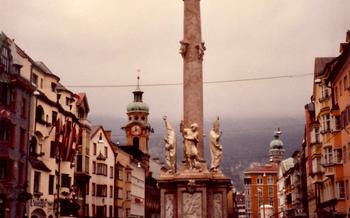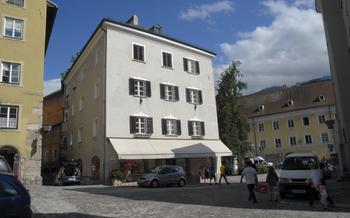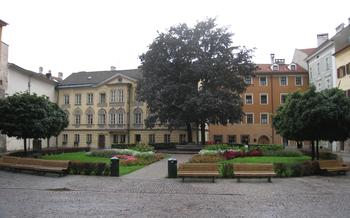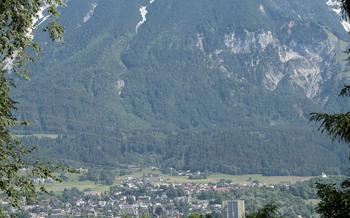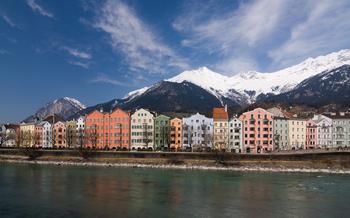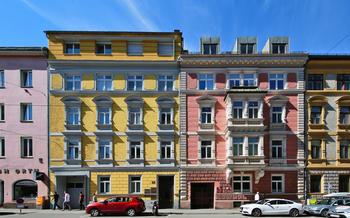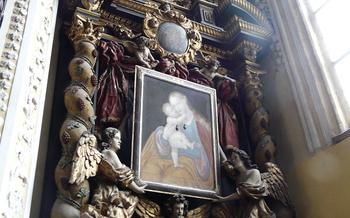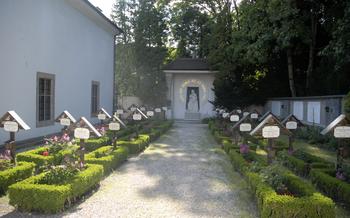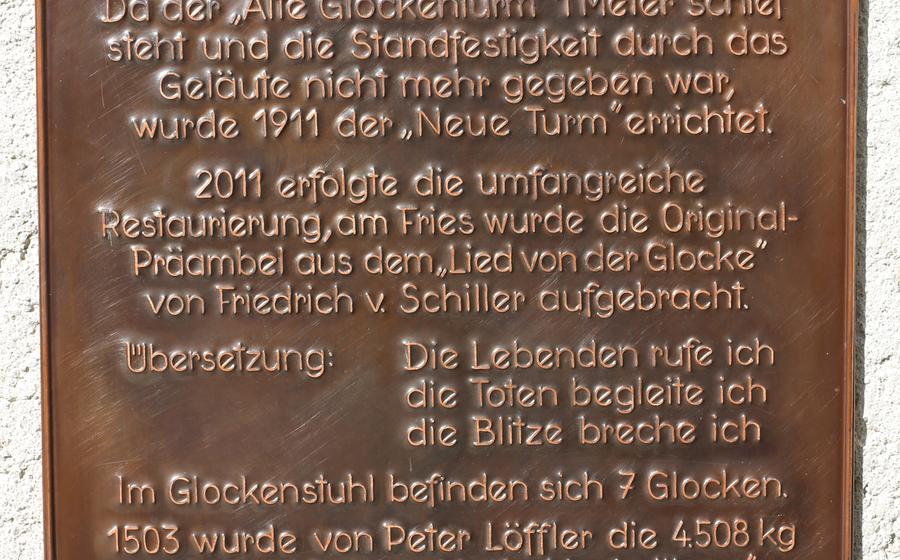
Schloss Ambras Innsbruck
- Schloss Ambras Innsbruck: A Journey Through Time
- Exploring the Habsburg Residence
- The Ambras Castle Museum
- The Spanish Hall: A Masterpiece of Renaissance Architecture
- The Ambras Art Collection
- The Chamber of Wonders: A Cabinet of Curiosities
- The Armory: A Glimpse into Medieval Warfare
- The Pleasure Garden: A Renaissance Oasis
- The Court Chapel: A Sacred Space
- The Hunting Lodge: A Princely Retreat
- The Park: A Natural Playground
- Events and Festivals at Schloss Ambras
- Practical Information for Visitors
- Getting to Schloss Ambras Innsbruck
- Insider Tip: Explore the Hidden Gems
Schloss Ambras Innsbruck: A Journey Through Time
Nestled amidst the stunning Tyrolean Alps, Schloss Ambras Innsbruck stands as a testament to the grandeur and history of the Habsburg dynasty. Constructed in the 16th century, this magnificent Renaissance castle has undergone several transformations, reflecting the changing tastes and aspirations of its illustrious owners. With its well-preserved architecture, impressive museum collections, and captivating guided tours, Schloss Ambras offers a mesmerizing journey through time, inviting visitors to step into the world of royalty and immerse themselves in the rich tapestry of Austrian history.
Exploring the Habsburg Residence
The history of Schloss Ambras is inextricably linked to the Habsburg dynasty, one of Europe's most influential ruling families. Archduke Ferdinand II of Tirol, a passionate art collector and patron of the arts, transformed the medieval fortress into a magnificent Renaissance palace in the 16th century. Schloss Ambras served as a beloved residence for Ferdinand and his family, reflecting their refined taste and appreciation for the finer things in life.
The interiors of the castle showcase the opulence and grandeur of Habsburg rule. Visitors can marvel at the intricate tapestries, finely carved wooden paneling, and elegant furniture that adorn the grand halls and chambers. Ferdinand's personal belongings, including his impressive collection of armor and weapons, offer a glimpse into the life and passions of this remarkable Habsburg ruler.
Schloss Ambras stands as a testament to the Habsburgs' love of art, culture, and their enduring legacy as patrons of the Renaissance. Its transformation from a medieval stronghold to a Renaissance gem reflects the dynasty's commitment to progress, innovation, and the pursuit of knowledge.
The Ambras Castle Museum
The Ambras Castle Museum is a treasure trove of art and artifacts, housing an extensive collection that spans centuries and cultures. Among the highlights of the museum are the renowned Ambras Art Collection, the Chamber of Wonders, and the Armory.
The Ambras Art Collection features a remarkable array of paintings by renowned masters such as Titian, Veronese, and Dürer. Visitors can admire stunning portraits, landscapes, and religious works that showcase the artistic brilliance of the Renaissance and Baroque periods.
The Chamber of Wonders, a curiosity cabinet par excellence, houses an eclectic collection of natural specimens, exotic artifacts, and scientific instruments. It offers a glimpse into the Renaissance fascination with the natural world and the desire to understand its mysteries.
The Armory, with its impressive display of weapons and armor, transports visitors back to the days of medieval warfare. It showcases a wide range of armor, helmets, swords, and firearms, providing insights into the evolution of warfare and the technology of combat.
The Spanish Hall: A Masterpiece of Renaissance Architecture
The Spanish Hall, or Spanische Saal in German, is the architectural and artistic centerpiece of Schloss Ambras Innsbruck. Built in the mid-16th century under the patronage of Archduke Ferdinand II, the hall is considered one of the finest examples of Renaissance architecture in Austria.
The hall's design is attributed to Italian architect Giovanni Battista Guarienti. Its spacious interior, measuring 43 meters in length and 11 meters in width, is characterized by elegant proportions and a harmonious fusion of architectural elements. The walls are adorned with intricate stucco work, while the ceiling features a series of elaborate frescoes.
The highlight of the Spanish Hall is its murals, which depict scenes from Habsburg history and mythology. These magnificent paintings were created by a team of talented artists, including Hans Rottenhammer, Hans von Aachen, and Joseph Heintz the Elder. The murals bring to life key moments from the Habsburg dynasty's storied past, including battles, coronations, and marriages.
The Spanish Hall's ceiling paintings are equally impressive. They depict scenes from Greek and Roman mythology, as well as allegories of the virtues and the arts. The central ceiling fresco, painted by Hans von Aachen, shows Apollo and the Muses on Mount Parnassus. The vibrant colors and dynamic compositions of the ceiling paintings create a sense of grandeur and awe.
The Spanish Hall was not only a place for official ceremonies and receptions but also a symbol of the Habsburgs' power and prestige. Its opulent decoration and impressive dimensions were designed to impress visitors and underscore the dynasty's status as one of the most powerful in Europe. Today, the Spanish Hall remains a testament to the Habsburgs' architectural and artistic legacy and is a must-see attraction for visitors to Schloss Ambras Innsbruck.
The Ambras Art Collection
The Ambras Art Collection housed within Schloss Ambras Innsbruck is a treasure trove of artistic masterpieces from the Renaissance and Baroque periods. Paintings by renowned masters such as Albrecht Dürer, Lucas Cranach the Elder, and Hans Holbein the Younger adorn the walls of the castle, capturing the essence of the era with their vibrant colors and intricate details. Alongside these paintings, the collection also boasts an impressive array of sculptures, tapestries, and decorative arts, showcasing the diverse artistic expressions of the time.
One of the highlights of the collection is the Ambras Portrait Gallery, which features a series of portraits of Habsburg rulers and their families. These portraits offer a glimpse into the lives and personalities of the Habsburgs, providing a fascinating insight into their power and influence. The gallery is a testament to the artistic patronage of the Habsburgs and their commitment to preserving their legacy through art.
Another noteworthy aspect of the Ambras Art Collection is its extensive collection of tapestries. These exquisite tapestries depict a variety of subjects, from mythological scenes to historical events, and are renowned for their intricate designs and vibrant colors. The tapestries not only served as decorative elements but also as a means of storytelling, conveying moral lessons and historical narratives to the viewers.
The Ambras Art Collection is a testament to the discerning taste and artistic sensibilities of Archduke Ferdinand II. His passion for collecting and his commitment to preserving these works of art have ensured that the collection remains one of the most significant and well-preserved Renaissance art collections in the world.
The Chamber of Wonders: A Cabinet of Curiosities
Among the many treasures of Schloss Ambras, the Chamber of Wonders stands out as a testament to the Renaissance fascination with the natural world and the pursuit of knowledge. This extraordinary cabinet of curiosities houses a diverse collection of natural specimens, exotic artifacts, scientific instruments, and inventions, reflecting the intellectual curiosity and global reach of the Habsburg court.
The collection includes an array of fascinating objects, from seashells and fossils to exotic animals and plants, each carefully cataloged and arranged to showcase its unique properties. Visitors can marvel at the intricate details of intricate seashells, the preserved remains of long-extinct creatures, and the vibrant colors of tropical birds.
Scientific instruments, such as globes, astrolabes, and sundials, demonstrate the Habsburgs' interest in astronomy, navigation, and timekeeping. Inventions like mechanical clocks and automata reveal the ingenuity and creativity of Renaissance craftsmen.
The Chamber of Wonders is not merely a collection of curiosities but a symbol of the Renaissance spirit of inquiry and exploration. It offers a glimpse into the intellectual pursuits of the Habsburg court and the broader cultural context of the Renaissance, where the natural world was seen as a source of wonder, knowledge, and inspiration.
The Armory: A Glimpse into Medieval Warfare
The armory at Schloss Ambras Innsbruck is a treasure trove of medieval weaponry and armor, offering a fascinating glimpse into the art of warfare during the Middle Ages. With over 500 pieces on display, the collection is one of the most significant of its kind in Europe.
The armory showcases a wide range of weapons, from swords and daggers to crossbows and firearms, each representing a different era and style of combat. Visitors can admire the intricate craftsmanship of the weapons, as well as the evolution of warfare technology over the centuries.
Among the highlights of the collection are several suits of armor, including one belonging to Archduke Ferdinand II himself. These impressive suits, made of finely crafted steel, provide a tangible sense of the protection and power that knights relied on in battle.
The armory also features a collection of historical firearms, including early muskets and wheellock rifles. These weapons revolutionized warfare during the Renaissance period, and their presence at Schloss Ambras highlights the castle's role as a center of innovation and military prowess.
Interactive displays and demonstrations enhance the visitor experience, providing insights into the use and effectiveness of the weapons. Visitors can learn about the different fighting techniques employed by medieval knights and witness demonstrations of archery and swordsmanship.
The armory at Schloss Ambras Innsbruck is a must-see for anyone interested in medieval history and warfare. It offers a unique opportunity to explore the weapons and armor that shaped the course of European history and to gain a deeper understanding of the art of combat during the Middle Ages.
The Pleasure Garden: A Renaissance Oasis
The pleasure garden at Schloss Ambras Innsbruck is a stunning example of Renaissance landscape design. Created in the 16th century, the garden was designed to provide a place for leisure and relaxation for the Habsburg court. The garden features a variety of rare and exotic plants, as well as statues, fountains, and a labyrinth.
One of the highlights of the garden is the Grottenhof, a courtyard surrounded by a series of grottoes. The grottoes are decorated with stalactites and stalagmites, as well as statues and paintings. The Grottenhof was a popular place for the Habsburgs to entertain guests and enjoy the cool air in the summer months.
Another highlight of the garden is the Herrengarten, a formal garden with a central fountain. The Herrengarten is surrounded by a hedge maze and features a variety of colorful flowers and plants. The Herrengarten was a popular place for the Habsburgs to take walks and enjoy the beauty of the garden.
The pleasure garden at Schloss Ambras Innsbruck is a beautiful and tranquil oasis that offers visitors a glimpse into the world of the Habsburg court. The garden is a popular destination for tourists and locals alike, and it is a great place to relax and enjoy the outdoors.
The Court Chapel: A Sacred Space
The Court Chapel, also known as the Chapel of St. Nicholas, is a beautiful and sacred space within the walls of Schloss Ambras Innsbruck. Built in the 16th century, the chapel served as a private place of worship for the Habsburg family and their guests. It is an excellent example of Renaissance architecture, featuring intricate carvings, stained glass windows, and a stunning altarpiece.
The chapel's interior is adorned with exquisite artwork and decorations, including paintings by renowned artists of the time. The altar features a magnificent altarpiece depicting the Adoration of the Magi, a common theme in Renaissance art. The chapel also houses several sculptures, including a life-size figure of the Virgin Mary.
Beyond its aesthetic beauty, the Court Chapel holds religious significance for the Habsburg family. It was here that Archduke Ferdinand II and his wife, Philippine Welser, were married in a secret ceremony. The chapel was also used for baptisms, weddings, and other important religious ceremonies of the Habsburg court.
Today, the Court Chapel is open to visitors as part of the Schloss Ambras Innsbruck museum. It remains a popular destination for those interested in history, art, and religion. Visitors can admire the chapel's beauty, learn about its history, and experience the sacred atmosphere that surrounds it.
The Hunting Lodge: A Princely Retreat
Archduke Ferdinand II, a passionate hunter, commissioned the construction of a hunting lodge within the grounds of Schloss Ambras. Completed in 1571, the lodge served as a retreat for the Archduke and his guests during hunting expeditions in the surrounding forests.
The hunting lodge is a charming and secluded building, nestled amidst the trees of the park. It features a simple yet elegant design, with a gabled roof and a wooden facade. The interior is cozy and inviting, with warm wood paneling and a large fireplace.
The hunting lodge was decorated with hunting-related motifs, reflecting Archduke Ferdinand II's passion for the sport. The walls were adorned with tapestries depicting hunting scenes, and the furniture was carved with intricate designs of animals and hunting equipment.
The hunting lodge was a place where Archduke Ferdinand II could relax and indulge in his favorite pastime. He would often invite his friends and fellow hunters to join him at the lodge, where they would spend days hunting in the surrounding forests and feasting on the spoils of their hunts.
Today, the hunting lodge is open to visitors as part of Schloss Ambras Innsbruck. It offers a glimpse into the private life of Archduke Ferdinand II and his love of hunting.
The Park: A Natural Playground
The extensive park surrounding Schloss Ambras invites visitors to explore its natural beauty and tranquility. A network of walking trails and hiking paths winds through the park, leading visitors through towering trees, past babbling brooks, and across lush meadows. The park is home to a diverse array of plant life, including rare and exotic species, and offers stunning views of the surrounding mountains.
Visitors can take a leisurely stroll or embark on a more challenging hike, enjoying the fresh air and the company of nature. The park also features several picnic areas, where visitors can relax and enjoy a meal surrounded by the beauty of the natural surroundings.
Whether you're looking for a place to exercise, escape the hustle and bustle of the city, or simply enjoy a peaceful walk, the park at Schloss Ambras has something to offer everyone.
Events and Festivals at Schloss Ambras
Schloss Ambras Innsbruck comes alive with a variety of events and festivals throughout the year, offering visitors a chance to experience the castle in a unique and memorable way.
One of the highlights is the annual "Ambras Castle Concerts" series, which takes place during the summer months. These concerts feature renowned musicians performing classical and contemporary pieces in the stunning setting of the Spanish Hall.
For those interested in history, the castle hosts regular historical reenactments and performances. Visitors can witness scenes from the Habsburg era, brought to life by costumed actors and performers.
Theatrical productions are also staged at Schloss Ambras, offering a unique perspective on the castle's history and inhabitants. These productions often combine historical accuracy with artistic interpretation, creating a captivating experience for audiences.
In addition, the castle grounds are a popular venue for festivals and events throughout the year. From traditional Tyrolean folk festivals to contemporary art exhibitions, there is always something new to discover at Schloss Ambras.
Practical Information for Visitors
Opening Hours and Admission Fees
Schloss Ambras Innsbruck is open to the public from Tuesday to Sunday, from 10 am to 5 pm. Admission fees vary depending on the type of ticket and any special exhibitions or events. Regular admission for adults is currently set at 12 euros, while reduced admission for students and seniors is 9 euros. Family tickets and group discounts are also available.
Guided Tours and Audio Guides
Guided tours of the castle are offered in German and English at regular intervals throughout the day. Tours typically last around 60 minutes and provide an in-depth look at the history, architecture, and collections of Schloss Ambras. Audio guides are also available in multiple languages for self-guided tours.
Accessibility for Visitors with Disabilities
Schloss Ambras Innsbruck is wheelchair accessible, with ramps and elevators providing access to all floors of the castle. Accessible restrooms and designated parking spaces are also available for visitors with disabilities.
Facilities and Amenities Available On-Site
The castle grounds feature a gift shop where visitors can purchase souvenirs and mementos of their visit. Restrooms, a café, and a restaurant are also located on-site, providing refreshments and dining options for visitors.
Getting to Schloss Ambras Innsbruck
Schloss Ambras Innsbruck is conveniently located just a short distance from the city center. Visitors can easily reach the castle by public transportation, with several bus lines stopping nearby. For those arriving by car, there is ample parking available on-site.
If you are driving, take the A12 Inntal Autobahn and exit at Innsbruck-Ost. Follow the signs for Schloss Ambras and you will reach the castle in a few minutes. Parking is available in the castle's car park, which is located next to the main entrance.
To get to Schloss Ambras by public transportation, take bus line 4123 from the Innsbruck Hauptbahnhof (main train station) or bus line 504 from the Innsbruck Westbahnhof (west train station). Both buses stop at the Schloss Ambras stop, which is located right in front of the castle entrance.
Once you arrive at Schloss Ambras, you can purchase tickets at the ticket office, which is located in the main courtyard. Guided tours of the castle are available in English and German, and audio guides are also available in several languages.
Insider Tip: Explore the Hidden Gems
Beyond the well-trodden paths, Schloss Ambras Innsbruck conceals a treasure trove of hidden gems waiting to be discovered by curious explorers. Secret passages and hidden rooms whisper tales of a bygone era, inviting visitors to unravel the castle's mysteries. Overlooked corners reveal stunning views, intricate details, and forgotten stories. From unique perspectives to exceptional photo opportunities, exploring these hidden gems offers a chance to experience Schloss Ambras in a truly unforgettable way. Embrace your inner explorer, let curiosity guide your steps, and uncover the secrets that lie in wait within these ancient walls.

